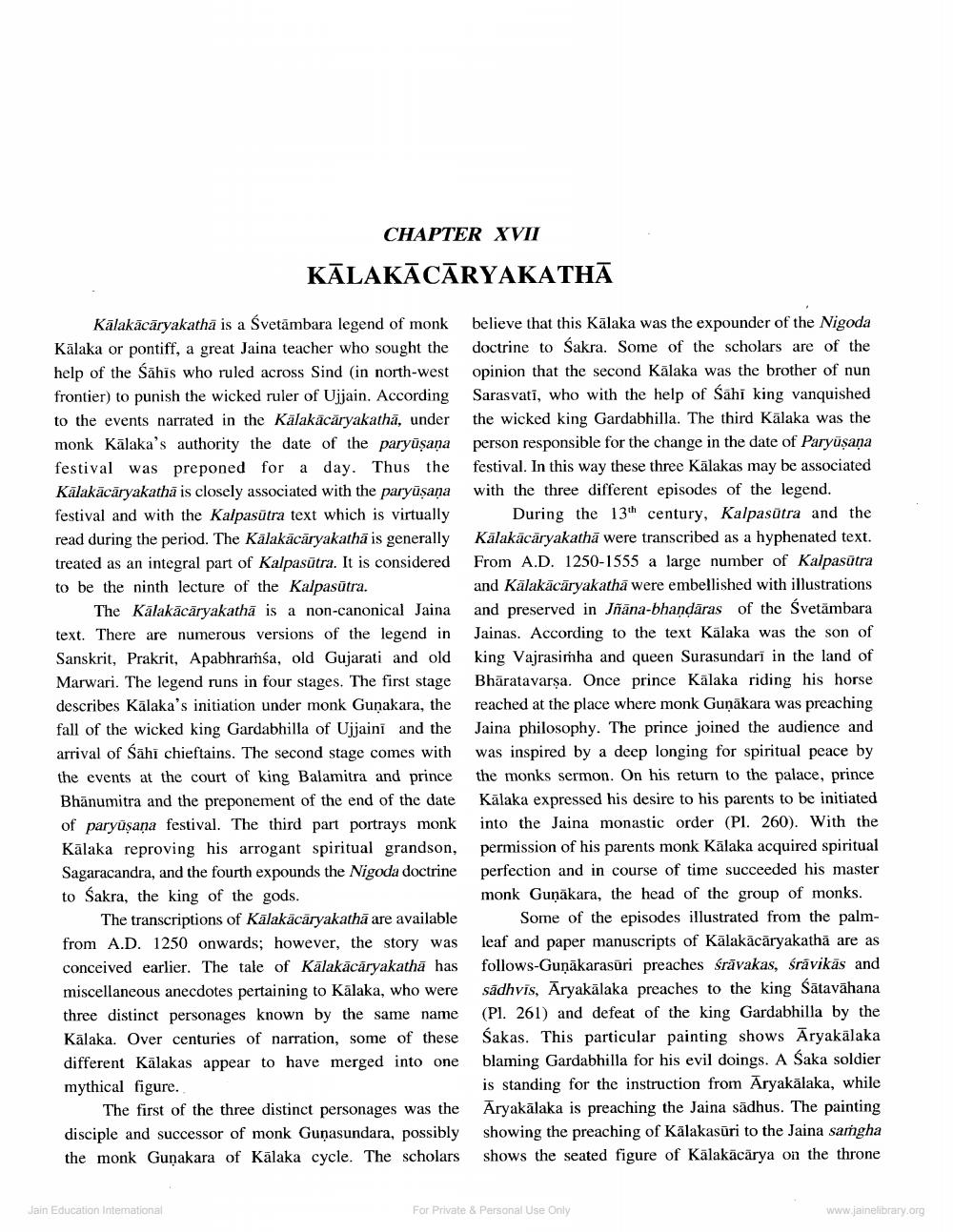________________
CHAPTER XVII KĀLAKĀCĀRYAKATHA
Kālakācāryakatha is a Svetāmbara legend of monk Kālaka or pontiff, a great Jaina teacher who sought the help of the Sāhis who ruled across Sind in north-west frontier) to punish the wicked ruler of Ujjain. According to the events narrated in the Kälakācāryakathā, under monk Kālaka's authority the date of the paryūṣana festival was preponed for a day. Thus the Kālakācāryakathā is closely associated with the paryüsaņa festival and with the Kalpasutra text which is virtually read during the period. The Kalakäcäryakatha is generally treated as an integral part of Kalpasūtra. It is considered to be the ninth lecture of the Kalpasūtra.
The Kālakācāryakatha is a non-canonical Jaina text. There are numerous versions of the legend in Sanskrit, Prakrit, Apabhramsa, old Gujarati and old Marwari. The legend runs in four stages. The first stage describes Kālaka's initiation under monk Gunakara, the fall of the wicked king Gardabhilla of Ujjaini and the arrival of Sāhi chieftains. The second stage comes with the events at the court of king Balamitra and prince Bhānumitra and the preponement of the end of the date of paryūṣaṇa festival. The third part portrays monk Kālaka reproving his arrogant spiritual grandson, Sagaracandra, and the fourth expounds the Nigoda doctrine to Sakra, the king of the gods.
The transcriptions of Kālakācāryakathā are available from A.D. 1250 onwards; however, the story was conceived earlier. The tale of Kälakācāryakathā has miscellancous anecdotes pertaining to Kālaka, who were three distinct personages known by the same name Kālaka. Over centuries of narration, some of these different Kalakas appear to have merged into one mythical figure.
The first of the three distinct personages was the disciple and successor of monk Gunasundara, possibly the monk Gunakara of Kälaka cycle. The scholars
believe that this Kālaka was the expounder of the Nigoda doctrine to Sakra. Some of the scholars are of the opinion that the second Kālaka was the brother of nun Sarasvati, who with the help of Sahi king vanquished the wicked king Gardabhilla. The third Kālaka was the person responsible for the change in the date of Paryūṣaṇa festival. In this way these three Kālakas may be associated with the three different episodes of the legend.
During the 13th century, Kalpasutra and the Kālakācāryakathā were transcribed as a hyphenated text. From A.D. 1250-1555 a large number of Kalpasūtra and Kālakācāryakathā were embellished with illustrations and preserved in Jñana-bhandāras of the Svetämbara Jainas. According to the text Kalaka was the son of king Vajrasimha and queen Surasundari in the land of Bhāratavarşa. Once prince Kalaka riding his horse reached at the place where monk Gunakara was preaching Jaina philosophy. The prince joined the audience and was inspired by a deep longing for spiritual peace by the monks sermon. On his return to the palace, prince Kālaka expressed his desire to his parents to be initiated into the Jaina monastic order (Pl. 260). With the permission of his parents monk Kālaka acquired spiritual perfection and in course of time succeeded his master monk Gunakara, the head of the group of monks.
Some of the episodes illustrated from the palmleaf and paper manuscripts of Kälakācāryakatha are as follows-Guņākarasuri preaches śrāvakas, śrávikäs and sãdhvis, Aryakālaka preaches to the king Sātavāhana (Pl. 261) and defeat of the king Gardabhilla by the Sakas. This particular painting shows Āryakälaka blaming Gardabhilla for his evil doings. A Saka soldier is standing for the instruction from Aryakälaka, while Aryakālaka is preaching the Jaina sädhus. The painting showing the preaching of Kälakasüri to the Jaina samgha shows the seated figure of Kälakācārya on the throne
Jain Education Intemational
For Private & Personal Use Only
www.jainelibrary.org




